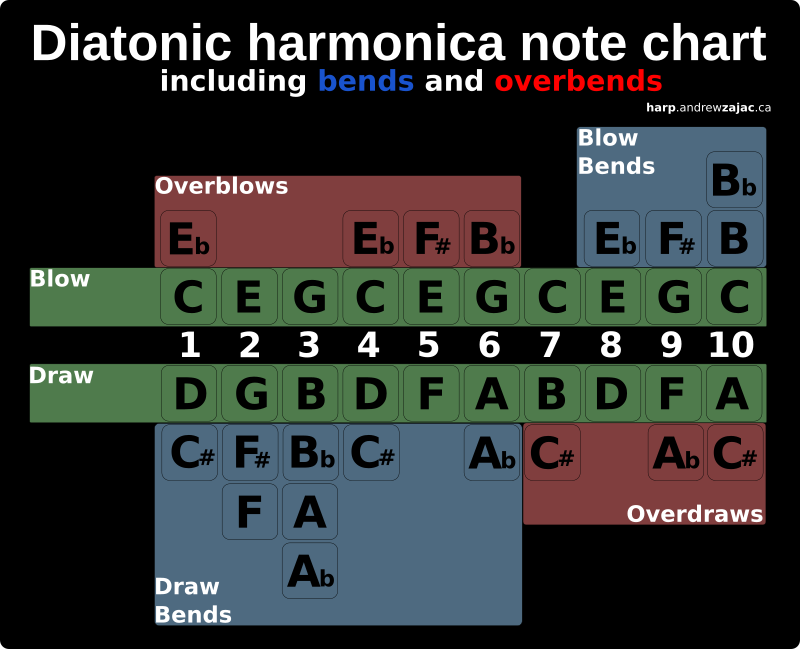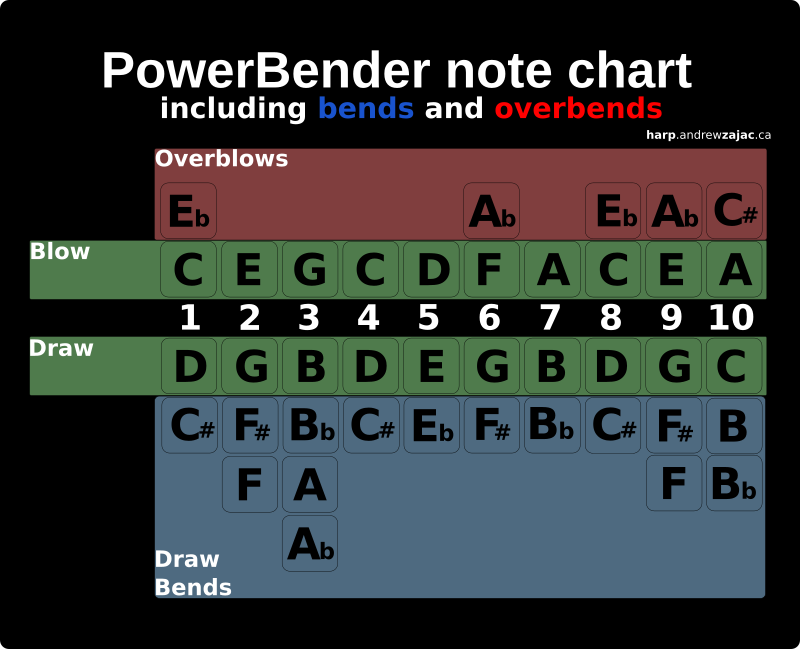Standard Richter tuning offers a lot of possibilities to make music. You have easy access to some useful chords, splits and octaves, you have a clean major scale in the middle octave and soulful draw bends and blow bends on the lower and upper octaves.

How do draw and blow bends work?
The draw bends on holes 1 to 4 and hole 6 use resonance to make one reed slow down (and eventually stop) and make the other reed move. As you lower the pitch of the 2 draw for example, the draw reed slows down and the *blow* reed starts to move. As you continue to lower the pitch to hit the next semitone bend, the draw reed will stop moving altogether and the blow reed will take over the work. This is a dual reed bend.
Blow bends on holes 8, 9 and 10 are the same but because the pitch of the blow note is higher than the draw note, the breath pattern is inverted and the bend is a blow bend, not a draw bend.
These are "regular" bends. Regular bends sound strong because they are dual reed bends and they are fairly easy to play. With a little practice most players can bend notes effectively on any working harmonica.
With unbend notes and "regular" bends, you can play various scales in different positions.
There's no other instrument that has quite the same connection between the player and the instrument. It's the draw bends on the low-end of the harmonica that give it it's distinctive sound.
You can extend the number of available notes on the diatonic harmonica further. By adding in the missing notes it is possible to play a complete three octave chromatic scale.

Overbends are one way to play these missing notes.
An overblow or and overdraw is a single reed bend. Together they are called overbends and they are different than "regular" bends.
You play an overblow on a hole where the draw reed is higher than the blow reed (holes 1-6); you blow air and in the same way you use resonance to slow down a reed to create a regular bend, you use resonance to stop the blow reed and allow the *draw* reed to make a sound. It will pop out a pitch about a semitone higher.
The same thing goes with an overdraw - you draw bend on a hole where the blow reed is higher than the draw reed.
"Regular bends" bend down - they provide notes that are lower than the unbent note. They play the notes between the blow and draw reeds. Overbends bend up - they provide notes that start a semitone above the pitch of the higher pitched reed.
A good way to learn to play overbends is to take the covers off a harp and mute certain reeds. For example, put your finger on the 4 blow slot and try playing the 4 blow. Nothing will happen unless you "feel around" with your embouchure. Try creating an air pocket in the front of your mouth as you play the note.
Once you get the right size pocket, the resonance will match the pitch you need and the *draw* reed will start to play the 4 OB note.
Reeds don't really like to stand still. Overbends tend to squeal when played on harmonicas that are not set up to play them well. It can happen that overbends can be played on stock harps but it's not a realistic expectation; most instruments will need some setting up to play overbends reliably. You can "cheat" and "roll off" the draw note to hit the overblow much more reliably but this limits the application of the note. Try to play all overbends "straight on" without any momentum to help you get the reeds to cooperate.
An overbend that's hard to play is difficult to incorporate into your playing. It can sound wrong. For this reason, some folks don't like overbends or they find them limiting.
Altered Tunings
Another way to play those missing notes is to alter the tuning. Country Tuning, Melody Maker, Minor tunings, Powerbender all allow you to play extra bends and add extra notes that are not there in Standard Richter.

To alter a tuning, you tune one or more reeds up or down so as to play a different note.
For example in Country tuning (major seventh) the draw five reed is raised one semitone. Instead of playing the flat seventh it plays the major seventh. By raising the pitch of the 5 draw reed, you are adding room between the blow and draw note. You can play the flat seventh note as a draw bend where in Standard Richter there is no available draw bend on hole five.
It's relatively easy to master the technique of raising or lowering the pitch of a reed. You can add weight to the tip of the reed in the form of BluTak or solder to lower the pitch. If you are lowering a pitch by a full semitone or more, I suggest you add weight to the tip to make most of the change and then file some material from the base of the reed to fine-tune the pitch. You can safely drop the pitch of a reed five semitones this way without risking damage to the reed or worrying too much about affecting the response and tone of the reed.
To raise the pitch of a reed, you must file material from the tip of the reed. Although some folks can raise a reed by four semitones this way, I find that more than one or two semitones is enough of a challenge and the reed's response and tone starts to degrade beyond that.
Reed swapping is also an effective way to alter tunings if you have access to extra reeds of the correct dimensions and are adept at reed replacement.
Altered tuning can be simple or you can completely overhaul the note layout. Remember that the soulful connection between the player and the instrument relies on those rich-sounding dual-reed draw bends on the low end of the harmonica. Alterations that turn those bent notes into straight notes take away the fun for me.
Each altered tuning means you will be learning a new breath pattern. At first players are apprehensive because they don't want to "forget" or lose their ability to play Standard Richter licks.
Don't worry! There's enough room in your brain to assimilate all of these breath patterns. Trust your muscle memory. A common mistake is to devote all practice time to the new altered tuning so as to master it quickly. I suspect any degradation in playing Standard Richter at that point is due to having stopped practising those licks rather than the "new" licks kicking out the old licks from your brain.
The net effect of mastering a new altered tuning is that you will become a better musician in all the tunings you have learned.
Half-Valving
Yet another way to play the missing notes is half-valving. A valve will isolate a reed so that you can bend one reed down without the other reed being allowed to participate. It's a single-reed bend like an overblow but you are using a valve to stop one of the reeds from moving rather than using resonance.

Take the covers off a harmonica and mute the six draw reed with your finger. Play the six blow and use your embouchure to bend the pitch down. You will be able to hit the missing note between five draw and six blow using that technique. With a valve over the six draw reed, you are able to play the blow, draw, draw bend and blow bent notes but you will not be able to play the overbend.
Half-valving can also let you intonate the pitch of some notes by shading them as you play them. You can use this to add expression to your playing.
Half-valving refers to only using one valve. If both reed slots were valved (full valving) you would not be able to play any bends.
In Standard Richter, half-valving means that there will be a valve on the inside of the hole on the draw plate on holes 1-6 and on top of the blow plate on holes 7-10.
Valves can be made of various materials. Ultrasuede is a resilient material. The valve is glued to the reed plate starting from the rivet tip on the side of the plate that's opposite from the reed.
Cut a thin strip so that it covers the width of the slot well. Trim it so that it leaves the first few millimeters of the tip of the slot free. You don't need to cover the whole slot for half-valving to work and leaving the tip free can help prevent the tone from being affected too much by the presence of a valve. It can also help prevent sticking of the valve.
All three methods (overbends, altered tunings, half-valving) are valid and used by many players. Pick your favourite!
Or not; you can make lots of good, soulful music with the Standard Richter layout.